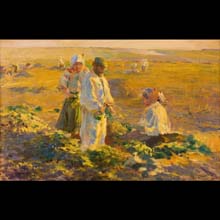
material: oil on canvas
dimensions: 45 × 70 cm
description: During his frequent stays in Ukraine between 1883 and 1911, Wyczółkowski painted several dozen pictures with a motif of beef-lifting. At present, only a few of them are known. In each of them, the artist worked on a different painterly problem concerning the influence of light on local colours, showing the changeability of this effect. He also took into account other factors, such as the morning or evening mist, rain or slight frost which made all the contours more pronounced. In the Beet-Lifting which is on display at the National Museum in Krakow the sunlight, turned into colourful, flickering reflections, falls on the encountered matter in the form of tiny dabs of pure pigment, giving it either a cool or a warm tone. It is one of these works by Wyczółkowski in which the artist was closest to Impressionist painting. The motif of the work of poor, simple people remained very important for him. He always emphasized that his Ukrainian paintings were of “folk” character. He had an honest and deep liking for Ukrainian peasants, lamenting their exploitation and treating them like objects by Polish landowners. Wacława Milewska
exposition: The Gallery of 19th Century Polish Art in Sukiennice,
The Cloth Hall, 1, Main Market Square
key: Realism, polish impressionism, beginnings of symbolism >>>
dimensions: 45 × 70 cm
description: During his frequent stays in Ukraine between 1883 and 1911, Wyczółkowski painted several dozen pictures with a motif of beef-lifting. At present, only a few of them are known. In each of them, the artist worked on a different painterly problem concerning the influence of light on local colours, showing the changeability of this effect. He also took into account other factors, such as the morning or evening mist, rain or slight frost which made all the contours more pronounced. In the Beet-Lifting which is on display at the National Museum in Krakow the sunlight, turned into colourful, flickering reflections, falls on the encountered matter in the form of tiny dabs of pure pigment, giving it either a cool or a warm tone. It is one of these works by Wyczółkowski in which the artist was closest to Impressionist painting. The motif of the work of poor, simple people remained very important for him. He always emphasized that his Ukrainian paintings were of “folk” character. He had an honest and deep liking for Ukrainian peasants, lamenting their exploitation and treating them like objects by Polish landowners. Wacława Milewska
exposition: The Gallery of 19th Century Polish Art in Sukiennice,
The Cloth Hall, 1, Main Market Square
key: Realism, polish impressionism, beginnings of symbolism >>>












